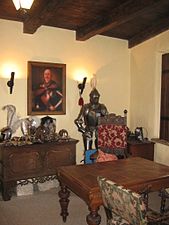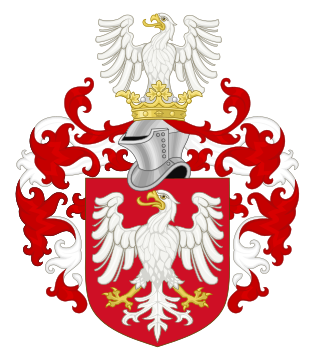
The House of Piast was the first historical ruling dynasty of Poland. The first documented Polish monarch was Duke Mieszko I. The Piasts' royal rule in Poland ended in 1370 with the death of King Casimir III the Great.
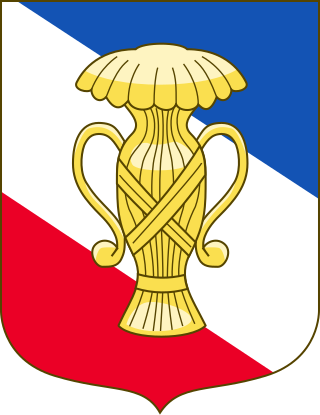
The House of Vasa or Wasa was an early modern royal house founded in 1523 in Sweden. Its members ruled the Kingdom of Sweden from 1523 to 1654 and the Polish–Lithuanian Commonwealth from 1587 to 1668; its agnatic line became extinct with the death of King John II Casimir of Poland in 1672.

The Royal Castle in Warsaw is a state museum and a national historical monument, which formerly served as the official royal residence of several Polish monarchs. The personal offices of the king and the administrative offices of the royal court were located in the Castle from the 16th century until the final partition of Poland in 1795. Situated in the Castle Square, at the entrance to the Old Town, the Royal Castle holds a significant collection of Polish and European art.

Dołęga is a Polish coat of arms. It was used by several szlachta families in the times of the Polish–Lithuanian Commonwealth.
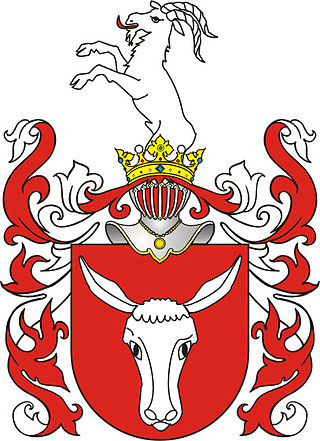
Półkozic is a Polish coat of arms. It was used by several szlachta families in the times of the Polish–Lithuanian Commonwealth.

The Czartoryski coat of arms is a Polish–Lithuanian coat of arms, a variant of the Pogoń Litewska arms. It has been used by the Gediminid Czartoryski family.
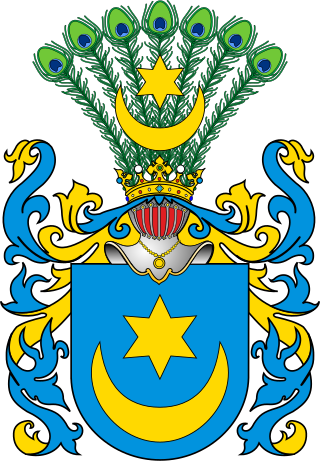
The House of Tarnowski is the name of a Polish noble and aristocratic family. Because Polish adjectives have different forms for the genders, Tarnowska is the form for a female family member.
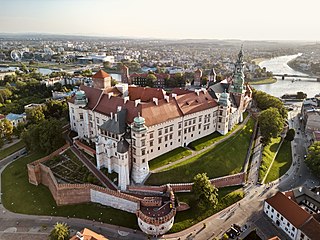
The Wawel Royal Castle and the Wawel Hill on which it sits constitute the most historically and culturally significant site in Poland. A fortified residency on the Vistula River in Kraków, it was established on the orders of King Casimir III the Great and enlarged over the centuries into a number of structures around an Italian-styled courtyard. It represents nearly all European architectural styles of the Medieval, Renaissance and Baroque periods.

Ostrzeszów is a town in south-central Poland, in Greater Poland Voivodeship. It is the capital of Ostrzeszów County. Ostrzeszów is located in the historical Wieluń Land. The population in 2023 was 14,095 inhabitants. The town is situated around 80 kilometres from Wrocław, 170 km from Katowice and 160 km from Poznań.

Bochotnica is a village in the administrative district of Gmina Kazimierz Dolny, within Puławy County, Lublin Voivodeship, in eastern Poland. It lies in historic province of Lesser Poland, approximately 3 kilometres (2 mi) north-east of Kazimierz Dolny, 10 km (6 mi) south of Puławy, and 42 km (26 mi) west of the regional capital Lublin. The village is located on the right bank of the Vistula, on the road between Puławy and Kazimierz Dolny. The ruins of a 14th-century castle are located nearby.

Chęciny is a town in Kielce County, Świętokrzyskie Voivodeship, southern Poland, with 4,361 inhabitants as of December 2021. It was first mentioned in historical documents from 1275, and obtained its city charter in 1325. At that time was one of major urban centers of northern Lesser Poland.

Chęciny Royal Castle was built in the late 13th century in Chęciny, Poland. It fell into ruin in the 18th century and remains in that state to this day.

The Grunwald Swords are a pair of simple bare swords sent as a mocking "gift" by Ulrich von Jungingen, the Grand Master of the Order of Teutonic Knights, to King Władysław II Jagiełło of Poland and Grand Duke Vytautas of Lithuania. The swords were sent on 15 July 1410, just before the Battle of Grunwald (Tannenberg), as a symbolic invitation to engage Jungingen's forces in battle. After the Polish–Lithuanian victory, both swords were taken as a war trophy by King Władysław II to Kraków, Poland's capital at the time, and placed in the treasury of the Royal Wawel Castle.

Bolko IV of Opole, was a Duke of Strzelce and Niemodlin during 1382–1400, Duke of Opole from 1396.

The Jagiellonian tapestries, are a collection of tapestries woven in the Netherlands and Flanders, which originally consisted of 365 pieces assembled by the Jagiellons to decorate the interiors of the royal Wawel Castle in Kraków, Poland. The collection is also collectively known as the Wawel Arrasses, as the majority of the preserved fabrics are in the possession of the Wawel Castle Museum and the French city of Arras, which was once a manufacturing centre of this kind of wall decoration in the beginning of the 16th century. The works became state property of the Crown of the Kingdom of Poland according to the will of Sigismund II Augustus.

Tenczyn Castle, also known as Tęczyn Castle, is a medieval castle in the village of Rudno in the Polish Jura, Poland. It was built as a seat of the powerful Tęczyński family. The castle fell into disrepair during the Deluge in mid-17th century, after being pillaged and burned by Swedish-Brandenburgian forces looking for the Polish Crown Jewels and rumored treasures of the Tęczyński family. Subsequently rebuilt, it again fell into disrepair after a major fire in the mid-18th century and remains in that state to this day.

Olsztyn Castle – castle ruins located in the Kraków-Częstochowa Upland, lying on the Trail of the Eagles' Nests – formerly protecting the southern border of the Kingdom of Poland. The ruins of the 14th-century castle are one of the biggest attractions of the area.
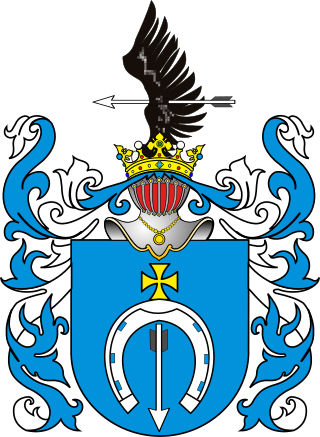
The Chodakowski family is a Polish-Lithuanian noble family. They originated in Mazovia in the Kingdom of Poland. The family was known to be in the Grand Duchy of Lithuania since the 16th century. They use the Dołęga Coat of Arms.

The Biel family - a Polish noble family with the Ostoja coat of arms, belonging to the heraldic Clan Ostoja (Moscics) originating from Błeszno.

Racibórz Castle is a stronghold mentioned in Gesta principum Polonorum of Gallus Anonymus in an entry dated to the year 1108. The first brick sections were likely built around the mid-13th century.












